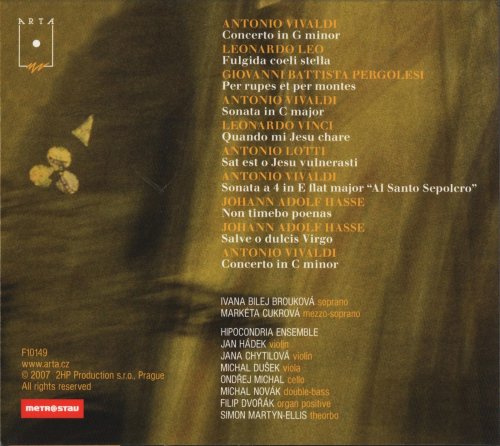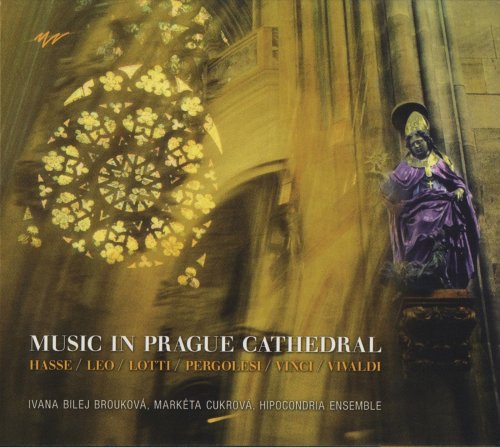
Ivana Bilej Brouková, Markéta Cukrová, Hipocondria Ensemble - Music in Prague Cathedral (2007)
BAND/ARTIST: Ivana Bilej Brouková, Markéta Cukrová, Hipocondria Ensemble
- Title: Music in Prague Cathedral
- Year Of Release: 2007
- Label: Arta
- Genre: Classical
- Quality: FLAC (image+.cue,log,scans)
- Total Time: 64:35
- Total Size: 306 Mb
- WebSite: Album Preview
Tracklist:
Antonio Vivaldi (1678-1741):
1. Concerto G minor (Antonio Vivaldi) 5:36
Leonardo Leo (1694-1744):
2. Fulgida coeli stella (Leonardo Leo) 5:12
Giovanni Baiista Pergolesi (1710-1736):
3. Per rupes et per montes (Giovanni Battista Pergolesi) 5:27
Antonio Vivaldi (1678-1741):
4. Sonata C major (Antonio Vivaldi) 4:08
Leonardo Vinci (1690-1730):
5. Quando mi Jesu chare (Leonardo Vinci) 3:23
Antonio Lotti (ca.1667-1740):
6. Sat est o Jesu vulnerasti (Antonio Lotti) 5:12
Antonio Vivaldi (1678-1741):
7. Sonata a 4 E flat major "Al santo sepolcro" (Antonio Vivaldi) 3:50
Johann Adolf Hasse (1699-1783):
8. Non timebo poenas (Johann Adolf Hasse) 6:27
9. Salve o dulcis Virgo (Johann Adolf Hasse) 4:58
Antonio Vivaldi (1678-1741)
10. Concerto C minor (Antonio Vivaldi) 5:29
Performers:
Ivana Bilej Brouková - soprano
Markéta Cukrová - mezzosoprano
Hipocondria Ensemble

Antonio Vivaldi (1678-1741):
1. Concerto G minor (Antonio Vivaldi) 5:36
Leonardo Leo (1694-1744):
2. Fulgida coeli stella (Leonardo Leo) 5:12
Giovanni Baiista Pergolesi (1710-1736):
3. Per rupes et per montes (Giovanni Battista Pergolesi) 5:27
Antonio Vivaldi (1678-1741):
4. Sonata C major (Antonio Vivaldi) 4:08
Leonardo Vinci (1690-1730):
5. Quando mi Jesu chare (Leonardo Vinci) 3:23
Antonio Lotti (ca.1667-1740):
6. Sat est o Jesu vulnerasti (Antonio Lotti) 5:12
Antonio Vivaldi (1678-1741):
7. Sonata a 4 E flat major "Al santo sepolcro" (Antonio Vivaldi) 3:50
Johann Adolf Hasse (1699-1783):
8. Non timebo poenas (Johann Adolf Hasse) 6:27
9. Salve o dulcis Virgo (Johann Adolf Hasse) 4:58
Antonio Vivaldi (1678-1741)
10. Concerto C minor (Antonio Vivaldi) 5:29
Performers:
Ivana Bilej Brouková - soprano
Markéta Cukrová - mezzosoprano
Hipocondria Ensemble
The Baroque look of Prague, with its countless volutes, pilasters, twisted mouldings, imaginary perspectives, and the impassioned gestures of statues, is largely due to the influence of the Roman Catholic Church, which was symbolically triumphant at the canonization of John Nepomucene in 1729. The Church played an even more striking role in the history of Czech music, when the Baroque style in the Bohemian Lands spread chiefly by means of church choirs. The celebration of the liturgy using music probably reached its peak in the Baroque. In each feast-day mass, and also at vespers, numerous processions, and other occasions, one heard polyphonic compositions performed with instrumental accompaniment. No large celebration would have taken place without the rolling of kettledrums and the blaring of brass, despite the occasional official prohibition. The use of music was tremendous, as is clear from the inventories and the rare preserved collections consisting of hundreds, sometimes even thousands, of pieces of sheet music. The Church, however, was not only the main source of commissions to composers, but also the main source of a musicians’ making a living, a situation that in some places lasted well into the nineteenth century. Among Prague churches the Cathedral of St Vitus had since earliest times a special place. This was reflected in the performance of music there and also, for example, in the social standing of the kapellmeister of St Vitus’s. The prestige of this position did not diminish till the founding of the Prague Conservatory in 1811 and the gradual secularization of society. Together with the collection of the Knights of the Cross with the Red Star at St Francis’s and of the Benedictines at Břevnov monastery, the collection at St Vitus’s is among the most important sources documenting church music in Prague in the first half of the eighteenth century – and this is true even though it by no means contains everything ever played in the Cathedral. Of the more than 1,700 pieces of sheet music that have survived, covering the period from the late seventeenth century to the first half of the nineteenth, most of it comes from the estates of two important Bohemian composers: Josef Antonín Sehling (or Seeling, 1710–1756), who worked in 1737–56 as the second violinist and deputy kapellmeister of Jan František Novák (d. 1771), and Jan Evangelista Antonín Koželuh (1738–1814), who led the choir at St Vitus’s Cathdral beginning in 1784. A large part of the collection comprises the works of the Bohemian composers František Xaver Brixi (1732–1771), one of the most famous Prague composers of his day and, from 1759, Choirmaster of St Vitus’s, and of Koželuh. The collection also includes other valuable individual works by earlier composers, for example, Antonín Reichenauer and Jan Dismas Zelenka (in Dresden). To judge from the number of pieces of sheet music, Antonio Caldara (1671–1736) was particularly popular at St Vitus’s. From 1717 he was employed as a court composer at Vienna, the capital of the Habsburg Monarchy. The influence of Vienna is evident also in the inclusion here of compositions by the court kapellmeister Johann Joseph Fux (1660–1741) and Georg Reutter (1708–1772).

Classical | FLAC / APE | CD-Rip
As a ISRA.CLOUD's PREMIUM member you will have the following benefits:
- Unlimited high speed downloads
- Download directly without waiting time
- Unlimited parallel downloads
- Support for download accelerators
- No advertising
- Resume broken downloads


